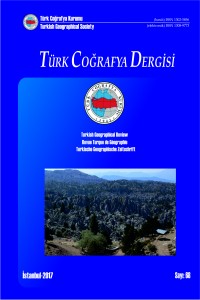Öz
The objective of this study is defining the effect of topographic slope differences, as being one of the parameters that affect GPR -a near surface geophysic and remote sensing technology, on measurement results, and to find out a solution to the problem of the unsystematic error resulted from slope area on GPR measurements with in the discipline of Geomatic Engineering by using recent survey methods and technologies. It is considered that it is possible to eliminate the errors resulted from area slope differences via GPS as being a widely used technology to acquire topographic data, by collecting and evaluating the relevant data simultaneously. Taking into consideration the methodology that objects the combination of GPR-GPS in local and foreign literature; there is not such an academic attempt to study the combination of GPR-GPS comparatively with classical GPR survey technique, thorough the buried reference object of which dimensions are known in advance. In order to test the performance of the method derived from the combination of GPR-GPS combination, buried object, of which dimensions are known in advance, will be considered as a reference, then two models of 3D; one 3D model that is provided by classical GPR survey sand another 3D model that is provided by the combination of GPR-GPS, was compared with the actual dimensions of the object. When comparing the results of the traditional GPR survey with those of the GPR-GPS combination, it has been noted that the GPR-GPS method produced beter horizontal point positioning precision, and the horizontal positioning uncertainty was improved about 28,2% for slope land types.
Anahtar Kelimeler
Kaynakça
- Alp, İ. Gelişli, K. Yılmaz, A. O., Kaya, R., Çavuşoğlu, (2003). Mermer İşletmeciliğinde Yer Radarı Uygulamaları. MRSEM 2003, Türkiye IV. Mermer Semposyumu. Bildiriler Kitabı, 37-48
- Dannowsky, G., Yaramancı, U., (1999). Estimation of water content ant porosity using combined radar and geoelectric measurements. European Journal of Environmental and Engineering Geophysics, 4, 71-85.
- Davis, J.L., Annan, A.P., (1989). Ground Penetrating Radar for high resolution mapping of soil and rock stratigraphy. Geophysical Prospecting, 37, 531-551.
- Grandjean, G., Gourry, J.C., (1999). GPR data processing for 3D fracturemapping in a marble quarry (Thassos, Greece). Journal of Applied Geophysics, 36, 19-30.
- Green, A., Gross, R., Holliger, K., Horstmeyer, H., Baldwin, J., (2003). Results of 3-D georadar surveying and trenching the San Andreas fault near its northern landward limit. Tectonophyisics, 368, 7-23.
- Harrari, Z., 1996. Ground penetrating radar (GPR) for imaging stratigrafic features and graundwater in sand dunes. Journal of Applied Geophysics, 36, 43-52.
- Lehmann, F., Green, G., (1999). Semiautomated georadar data acquisition in three- dimensions. Geophysics 64 (3), 719-731.
- Sun, J., Young, A., (1995). Scattering in ground-penetrating radar data. Geophsica 6 (5), 1378-1385.
- Conyers, L. B., (2004). Ground Penetrating Radar for Archeology, Altamira Press, ISBN 0-7591-0772 , s.23-55
- Sandmeier, K.J., (2004). Scientific Software, REFLEXW ver.3.5 program for processing and interpretation of reflection and transmission data.
Öz
Bu çalışmanın amacı sığ jeofizik görüntüleme ve uzaktan algılama teknolojisi olan GPR yöntemini etkileyen parametrelerden topoğrafik değişkenliğin ölçme sonuçlarına etkisini belirlemek ve söz konusu GPR ölçmelerinde arazi eğiminin sebep olduğu sistematik olmayan hatanın ortadan kaldırılması problemine Geomatik/Harita Mühendisliği disiplini içerisinde ölçme tekniğinin güncel metot ve teknolojilerini kullanarak çözüm bulabilmektir. Günümüzde yaygın olarak kullanılan GPS teknolojisi ile elde edilecek topoğrafik verilerin GPR ölçmeleriyle eşzamanlı olarak toplanması ve birlikte yorumlanması ile GPR ölçmelerinde arazi eğiminden kaynaklanan hatanın giderilmesinin mümkün olduğu düşünülmektedir. Yerli veya yabancı literatürde GPR-GPS kombinasyonundan oluşan metodolojiyi konu alarak; Klasik GPR ölçme tekniği ile GPR-GPS kombinasyonunun, boyutları önceden bilinen gömülü referans obje üzerinden karşılaştırmalı olarak analiz edildiği herhangi bir akademik çalışma bulunmamaktadır. GPR – GPS kombinasyonundan oluşan metodun performansının test edilebilmesi için boyutları önceden bilinen gömülü obje referans alınarak klasik GPR ölçmeleri ile elde edilen 3D model ve GPR-GPS kombinasyonundan elde edilen 3D model, referans objenin gerçek boyutlarıyla karşılaştırılmıştır. Klasik GPR yöntemi sonuçları, GPR-GPS kombinasyonu sonuçlarıyla karşılaştırıldığında hem düz ve hem de eğimli arazide GPS-GPR yönteminin daha duyarlı yatay nokta konum hatası ürettiği belirlenmiş, yatay nokta konum hatasının eğimli arazi türünde %28,2 civarında küçüldüğü/iyileştiği gözlemlenmiştir
Anahtar Kelimeler
Kaynakça
- Alp, İ. Gelişli, K. Yılmaz, A. O., Kaya, R., Çavuşoğlu, (2003). Mermer İşletmeciliğinde Yer Radarı Uygulamaları. MRSEM 2003, Türkiye IV. Mermer Semposyumu. Bildiriler Kitabı, 37-48
- Dannowsky, G., Yaramancı, U., (1999). Estimation of water content ant porosity using combined radar and geoelectric measurements. European Journal of Environmental and Engineering Geophysics, 4, 71-85.
- Davis, J.L., Annan, A.P., (1989). Ground Penetrating Radar for high resolution mapping of soil and rock stratigraphy. Geophysical Prospecting, 37, 531-551.
- Grandjean, G., Gourry, J.C., (1999). GPR data processing for 3D fracturemapping in a marble quarry (Thassos, Greece). Journal of Applied Geophysics, 36, 19-30.
- Green, A., Gross, R., Holliger, K., Horstmeyer, H., Baldwin, J., (2003). Results of 3-D georadar surveying and trenching the San Andreas fault near its northern landward limit. Tectonophyisics, 368, 7-23.
- Harrari, Z., 1996. Ground penetrating radar (GPR) for imaging stratigrafic features and graundwater in sand dunes. Journal of Applied Geophysics, 36, 43-52.
- Lehmann, F., Green, G., (1999). Semiautomated georadar data acquisition in three- dimensions. Geophysics 64 (3), 719-731.
- Sun, J., Young, A., (1995). Scattering in ground-penetrating radar data. Geophsica 6 (5), 1378-1385.
- Conyers, L. B., (2004). Ground Penetrating Radar for Archeology, Altamira Press, ISBN 0-7591-0772 , s.23-55
- Sandmeier, K.J., (2004). Scientific Software, REFLEXW ver.3.5 program for processing and interpretation of reflection and transmission data.
Ayrıntılar
| Bölüm | Araştırma Makalesi |
|---|---|
| Yazarlar | |
| Yayımlanma Tarihi | 26 Mayıs 2017 |
| Kabul Tarihi | 28 Mart 2017 |
| Yayımlandığı Sayı | Yıl 2017 Sayı: 68 |
Yayıncı: Türk Coğrafya Kurumu


